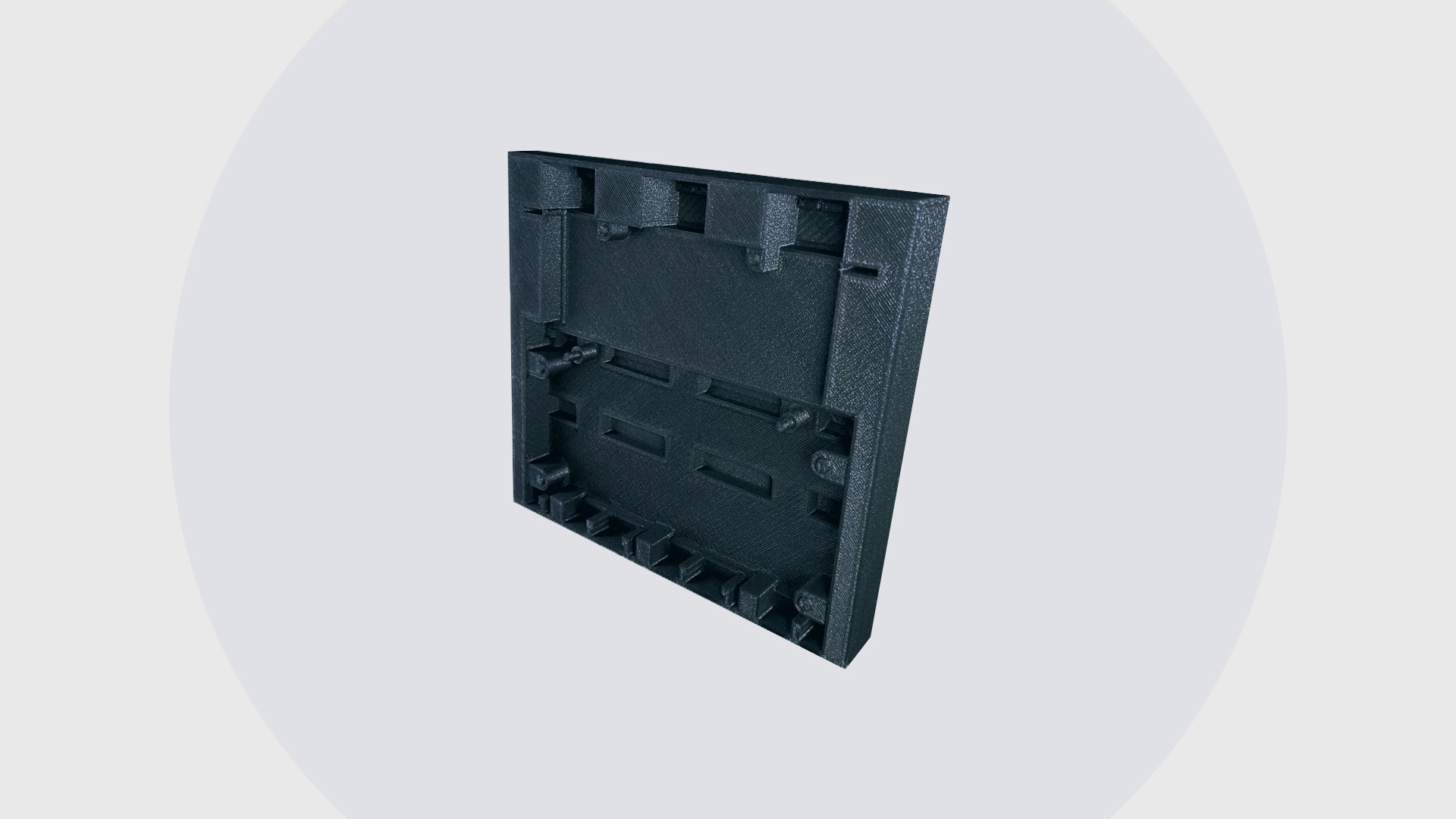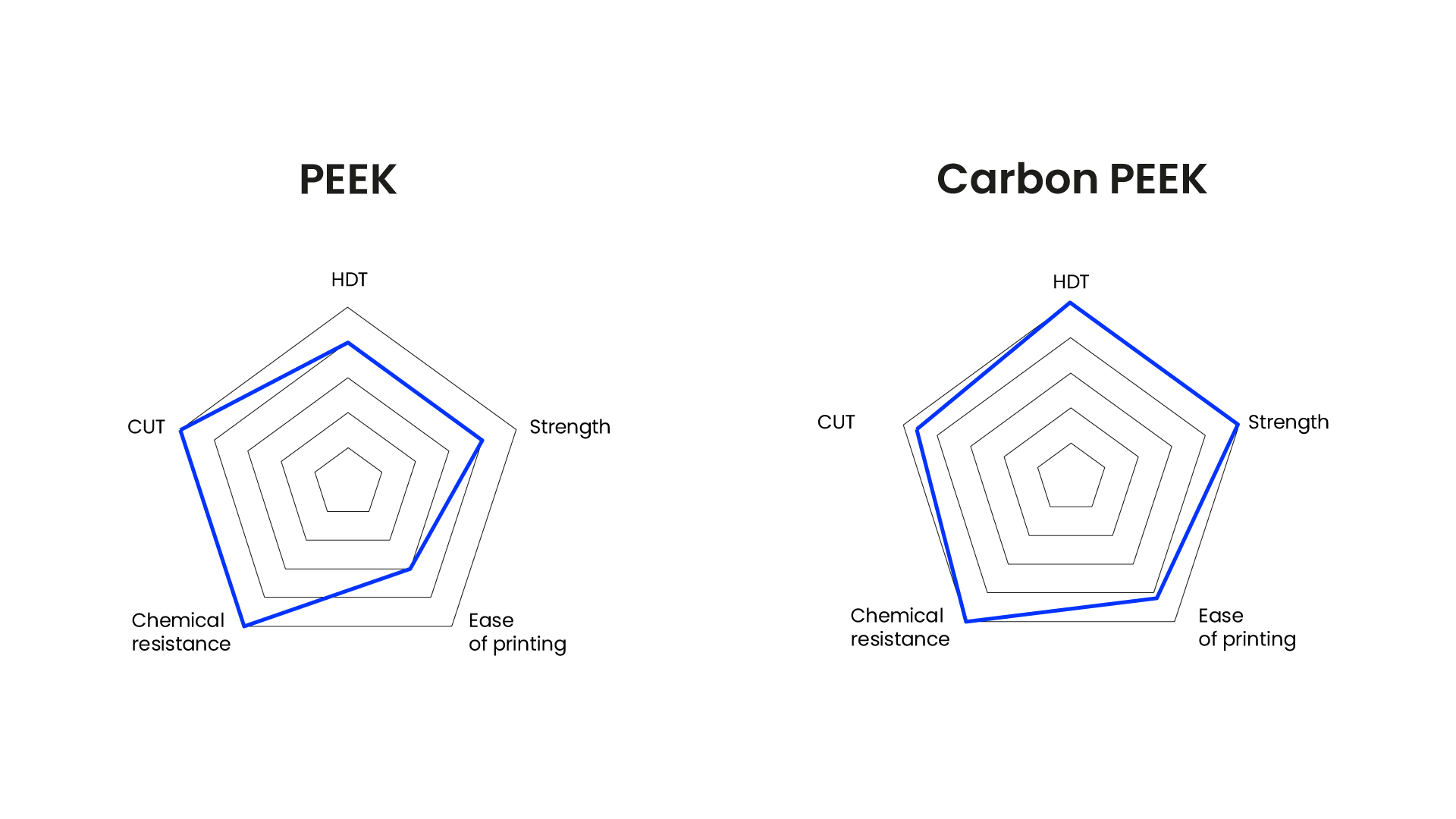
3D printing Carbon PEEK: what is Carbon PEEK and what is it used for?
What is Carbon PEEK?
Carbon PEEK is a composite material 3D printed by Roboze. It is a Carbon fiber reinforced - CFR PEEK made with 10% (by weight) chopped carbon fibers, added in a PEEK matrix.
Carbon PEEK is considered among the strongest of all thermoplastics at room temperature because it offers superlative properties that, together with its very good wear and abrasion resistance, make it ideal for the substitution of metals in more extreme environments.
Carbon PEEK material properties, table for 3D printing
The main properties of 3D printed Carbon PEEK parts are listed in the table below.
Table 1: Technical Data Sheet (TDS) of 3D Printed Carbon PEEK by Roboze
| Test method | Values | |
|---|---|---|
| Carbon PEEK MECHANICAL PROPERTIES | ||
| Tensile Strength (Ultimate) | ASTM D638 | XY 115 MPa XZ 138 MPa |
| Tensile Modulus | ASTM D638 | XY 14 GPa XZ 13.8 GPa |
| Compression Strength (Ultimate) | ASTM D695 | 229 MPa |
| Compression Modulus | ASTM D695 | 1.7 GPa |
| Carbon PEEK THERMAL PROPERTIES | ||
| Continuous Use Temperature | ASTM D3045 | 240 °C |
| Melting Point | ASTM D3418 | 343°C |
| CLTE (@23 °C - 150 °C) | ASTM D831 | XY 37*10-6 K-1 Z 85*10-6 K-1 |
| HDT @1.82 MPa | ASTM D648 | 280°C |
| Carbon PEEK PHYSICAL PROPERTIES | ||
| Density | ASTM D570 | 1.33 g/cm3 |
| Water Absorption | ASTM D792 | <0.45% |
| Moisture Absorption | ASTM D570 | <0.10% |
| UL 94 Flame Class Rating | UL 94 | V0 |
| Hardness | ISO 868 | 87 Shore D |
| Features | Self-lubricating | |
| Colour | Black | |
Physical and chemical properties of Carbon PEEK by Roboze
Carbon Fiber PEEK is a composite that belongs belongs to the high-performance polymers. Compared to neat PEEK, the carbon fibers provide it even higher mechanical strength, high temperature characteristics and superior chemical resistance, making it the material of choice for the harshest environments. Here the main properties of Carbon Peek:
- Mechanical Properties of Carbon PEEK
The reinforcement done with 10% chopped carbon fibers improves the compressive strength, stiffness, and load capacity of PEEK.
Carbon PEEK shows even higher mechanical properties, when compared to PEEK. Its Ultimate Tensile Strength (UTS) can reach up to 138 MPa, making it up to 35% stronger than PEEK and some Aluminium alloys, like Al 6063.
Carbon PEEK Tensile modulus is also very high, up to 14 GPa. This explains its brittle behavior and its outstanding toughness. It is 76% stiffer than PEEK, also because its tensile elongation is ten times lower than PEEK's, so, when it is subjected to stresses, it will not tend to deform before rupture.
The behavior of Carbon Fiber PEEK to compression loads is impressive: its compression strength is about 229 MPa.
- Thermal properties of Carbon PEEK
What is the thermal influence of Carbon fibers on a PEEK matrix? They are a blessing: the heat deflection temperature (HDT) of Carbon PEEK is considerably high, reaching up to 280°C, while neat PEEK’s HDT is around 150°C. The increase of this value is due to the thermal stability that is improved with carbon fibers, compared to neat PEEK.
Carbon PEEK has a higher thermal conductivity than unloaded PEEK and therefore offers a greater stability at high and low temperature, because of its lower coefficient of linear thermal expansion (CLTE).
- Physical properties of Carbon PEEK
3D printed Carbon PEEK is black and when fully crystalline, it looks slightly lighter, with some grey-blue shades. Adding carbon fibers on a PEEK matrix does not considerably increase its density: it is only 1,33 g/ cm3. One of the physical parameters that are more affected by the carbon reinforcement is the volume resistivity: since carbon fibers are electrically conductive, they increase the electrical properties of the insulated PEEK matrix.
Carbon fibers also influence the material hardness: it is tested to be 87 Shore D, making it very tough and placing it at the top of the Shore Hardness scale for polymers.
As well as PEEK, Carbon PEEK is inherently flame retardant (UL94 V0 FST): it hardly burns and when it does, it does not produce toxic fumes, so its use is safe in fire risk applications, for example in the Energy industry.
It may sound counterintuitive but generally Carbon PEEK offers a low dry friction, because of the self-lubricating properties of carbon fibers and the higher thermal conductivity of the particles: the heat does not localize on surfaces but it penetrates in the volume. Therefore, the friction coefficient of Carbon fiber reinforced PEEK is one third lower than PEEK’s.
Despite this, chopped carbon fibers inside any composite increase its roughness: these composites can scratch the materials that are in contact with it, so caution is needed in application in contact with softer materials.
Carbon fibers are not susceptible to UV degradation, therefore Carbon PEEK is fairly resistant to UV radiations and it has a very good resistance against high energy radiations as well.
Carbon fibers have a weak diamagnetic response in a static magnetic field. Therefore, carbon fiber is a kind of resistant-magnetic material. For this reason, the use of Carbon PEEK is limited in magnetic applications.
- Carbon PEEK Chemical properties
Carbon PEEK can be autoclavable, sterilized, and it is very resistant to hydrolysis in boiling water and superheated steam, as well as to organics, acids, and bases. These properties make this material ideal for the production of carbon fiber hand lay-up molds.
More generally, the carbon fibers reinforcement inside the PEEK matrix can be considered not to significantly vary the outstanding chemical resistance of PEEK itself. To analyze the chemical behavior of Carbon PEEK, check the chemical resistance tables.
PEEK vs Carbon-fiber-reinforced PEEK: when to use one or the other?
PEEK and Carbon PEEK belong to the same family; therefore, their properties are very similar. After explaining what is PEEK, the image below shows the main differences between PEEK and Carbon-fiber-reinforced PEEK.

Both PEEK and Carbon fiber reinforced - CFR PEEK show outstanding mechanical, thermal and chemical properties. But when you should prefer one over the other?
Here a short guide on the main applications where you would decide for PEEK or Carbon PEEK:
- Higher temperature applications will require a material that is more thermally stable: that’s the case of Roboze Carbon PEEK that has a heat deflection temperature (HDT) of up to 280°C, while PEEK can be used up to 250°C.
- Very-high-loaded applications will need Carbon PEEK, thanks to its outstanding UTS up to 138 MPa, compared to PEEK’s that reaches up to 89 MPa.
- In magnetic applications PEEK would be preferred, because of carbon fibers’ weak diamagnetic properties.
- Electric or thermal applications that require high insulation must use PEEK: carbon fibers inside CF-PEEK make it more conductive.
- Applications that need deformation before rupture (ductile rupture) should use PEEK thanks to its higher tensile elongation at break. Carbon fiber reinforced - CFR PEEK is more brittle and tends to break without deforming much (fragile rupture).
- When the shapes to print require an intensive support removal, Carbon PEEK would be preferred, because support structures are easier to remove thanks to the brittleness of the material, compared to PEEK supports that have a more ductile behavior.
Carbon Fiber Reinforced PEEK Applications
The impressive mechanical, thermal and chemical properties of Carbon PEEK allow its use in a wide range of industries. Here some examples of Carbon PEEK applications:
- Carbon PEEK for the Energy industry: chemical resistance is the most important point for Energy and Oil& Gas applications. Carbon PEEK resistance to chemicals, seawater and acids, together with its resistance to high temperatures, open the doors for extreme applications.
- Carbon PEEK for Aerospace and Defense industries: the excellent mechanical properties of Carbon PEEK allow the use of this material as a metal replacement. The weight reduction by using polymers instead of metals significantly reduces costs and fuel consumed to put components in flight.
- Carbon PEEK for the Transportation industry: production efficiency is a key point in the vehicle industry. The mechanical, thermal and chemical properties of this material, combined with the design freedom, allow for faster optimization of the design, test, and production processes.
Carbon PEEK 3D printing Roboze
Carbon fibers give PEEK a higher dimensional stability, diminishing its shrink rate, lowering it down to 0.5%, therefore reducing the warping effect. This results in improved geometrical tolerances of the printed part, especially with the planarity of flat surfaces.
Even though Carbon PEEK is easier to print, when compared to PEEK, because the carbon fibers stabilize the material even at higher temperatures, this material needs a heated chamber to guarantee that the thermal gap will not affect the properties of the printed part, eliminating the need for an additional post-process like annealing: we already talked about in a focus on what does a 3d printer need to print peek.
In fact, printing Carbon PEEK with a heated chamber, leads to the maximum crystallization of the polymer, resulting in better chemical, thermal and mechanical properties. Not to mention the accuracy and repeatability obtained with the homogeneous heat flow inside the heated chamber on board of Argo printers, designed by Roboze: the 3D printing process becomes more and more precise, allowing for the use in the most extreme applications.
Just like PEEK, Carbon Fiber Reinforced - CFR PEEK requires a very high extrusion temperature, up to 450°C. Hence the need for an extruder that can handle high viscosity fluids, like the HVP extruder, designed by Roboze’s R&D department.
Additive Manufacturing is one of the few technologies that is capable of enabling the alignment of carbon fibers in the extrusion direction. This great advantage is the reason for the extremely high mechanical properties of Carbon PEEK: the alignment of carbon fibers also has a positive influence in the electrical conductivity of Carbon PEEK. Furthermore, due to its very high strength, carbon fibers tend to quickly wear and abrade the extrusion tip, which generally needs to be replaced more frequently when compared to neat materials. Roboze HVP Extruder is designed to reduce the wear of the nozzle and of the whole extrusion system. The nozzle tip is designed in hardened steel with a polyphobic coating that has the aim to reduce wear, increasing the lifetime of the extruder head.
Being Carbon PEEK more fragile than PEEK, the post-printing process is simplified since the support structures can be removed more easily, despite the material strength.
